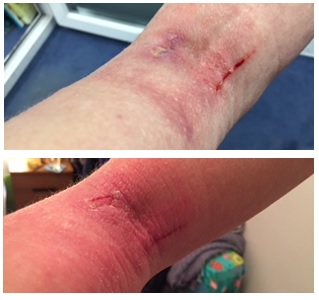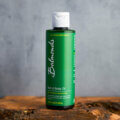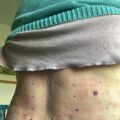If you have a latex allergy the chances are you are also allergic to plasters. I have known about my allergy to sticky plasters for years and usually have a stock of the hypo allergenic plasters but when you get an injury that requires something more that just a plaster what can you use?
I managed to get a branch embedded into my arm the other day resulting in a nasty oozing wound. It was OK for the first day with a large Melolin adhesive dressing, but it all started to go wrong after that.
Possibly because I bought some supermarket own brand dressings…
These pictues don’t really show how awful the skin became.

I tried just the padded non adhesive pads with bandage which seemed to just make things worse and didn’t stay in place very well. I don’t find the adhesive strips for keeping dressings in place ever stick to my skin at all. This is partly due to the emollients I use, and not using these is just not an option.
I wonder if the reaction was started and just triggered an eczema flare on that area of my arm which just didn’t want anything else on it… whatever it was it was not pleasant. It felt like burning and left my arm blistered in a square where the adhesive was. The itching of the arm was worse than the injury itself… go figure!
So I am also allergic to Melolin dressings and the steri stip stuff.
I gave up with the large dressings when the actual sticky bit ripped a long slit wound right up my arm where it had stuck to the skin. You can see this in the pictures above. Bled like nothing else. Man that was painful, and felt much worse than the original wound. Pain is a weird thing.
So we were not doing well with this bloomin wound… although I have mastered the art of bandaging my own arm one handed!
No or low allergen alternatives for larger wounds
So after some research we will be better prepared should there be a next time.
- Lint – absorbant lint is just a square af plain cotton padding. This did stick to the wound a bit but did not irrirate my skin. After cutting it to size and making a pad with a few layers I was then able to bandage the arm loosely. Fast Aid Absorbent Lint 500g
- Robinson’s Skintact dressings – These were recommended on a forum I discovered. I haven’t tried them yet but have ordered some for my next disaster. I do appear to be becoming a tad accident prone! You can buy these on Amazon but I’ve not found them anywhere else. (Pack Of 20) Robinsons Skintact Sterile First Aid Dressings 10cm X 10cm – Dual-sided, low-adherent perforated film dressings.
- Non adhesive dressings with a tubi grip – I didn’t get around to doing this but it was one of the ideas I toyed with. By this point I had decided to try to leave it uncovered and just wear long sleeves to protect it. I would try this in the future as bandaging ones own arm is not easy.
- Jelonet – another forum suggested Jelonet but I don’t know enough about this one. I thought I would include it just in case it helps, should you find yourself on a similar painful journey.
- Manuka Honey dressings – I also found these while researching this blog. It’s a gauze that you apply to skin and then bandage over the top. Actilite Manuka Honey Dressings 10cm x 10cm Box of 10 Dressings
But do you know what felt the best? Once the skin was inflamed and angry anything felt uncomfortable, but I still wanted to keep the wound protected. The only thing that didn’t feel unpleasant was to wear a merino wool long sleeved top and no dressing. The feel of merino against my arm was cooling and soothing.
Savlon just irritated me even more. Healing and soothing the awful outcome was the next job and I found Tea Tree, Aloe Vera and Balmonds Skin Salvation (Use my Promo code WHATALLERGY for 20% off all Balmonds products) were the only things that worked; couple this with taking some antihistamines to help with the incessant itching and the allergic reaction eventually subsided, which took about a week!
So be careful my allergic ones. Avoid major wounds in the first place if you can obviously, but if you do need some proper dressings be very careful what you put on your sensitive skin.
You will all be pleased to hear that the arm is now almost completely healed and the skin is back to normal, it a little itchy. Has anyone else had a similar experience with these dressings? What did you do?












I just use the non sticky melolin dressings so it dosn’t stick to the wound then use the paper tape that they use in the NHS if it starts to stick when removing I use a very damp flannel or sponge and peal slowly. I have also had the problem of taking plaster off along with the skin which the makes the problem even worse, the other thing I use is QV cream under the melolim. So it therefore shouldn’t stick to the wound and yes using shops own brand is a bad move. I am also allergic to things like tea tree and aloe Vera along with loads of other natural things so have to take even more care with what I use on open wounds.
Thanks Ian, that is great advice. To gently remove the dressing with a sponge. I clearly rushed it and tore off the plaster in a big quick movement. NEVER EVER again. It hurt more than the gaping wound. LOL. Hopefully neither of us will require this treatment but I will look into QV cream. I haven’t used that before.
Hi Ruth. Hope you are well as can be. Nasty wound! Back in the day when working on acute wards we would use jelonet for such wounds where it kettle the wound and surrounding tissue moist. It seemed to hold well under a wide cotton bandage. We would change it as required every couple of days or so. Worth a try but it’ll be pricey.
Ian’s suggestion of making damp the other type of “sticky” bandages and tape is good. Helps avoid tearing and lessons pain.
Thanks Andrew! A great suggestion though I hope I don’t have another wound so I’ll never need to try it but it makes perfect sense. Just saw you photed in the news about super pollen and hay fever. How are you?
I have used manuka honey dressings &it was really effective. In fact, i would highly recommend it for the malodorous wounds.
Contact dermatitis can be further subdivided into irritant contact dermatitis ICD and allergic contact dermatitis ACD , depending on the relevant pathophysiology and aetiology. Irritant contact dermatitis is an inflammatory reaction caused by direct physical or chemical damage to the skin.
Thanks for explaining that. It think understanding this can help us manage the conditions.